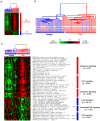Gene expression signature in peripheral blood detects thoracic aortic aneurysm
- PMID: 17940614
- PMCID: PMC2002514
- DOI: 10.1371/journal.pone.0001050
Gene expression signature in peripheral blood detects thoracic aortic aneurysm
Abstract
Background: Thoracic aortic aneurysm (TAA) is usually asymptomatic and associated with high mortality. Adverse clinical outcome of TAA is preventable by elective surgical repair; however, identifying at-risk individuals is difficult. We hypothesized that gene expression patterns in peripheral blood cells may correlate with TAA disease status. Our goal was to identify a distinct gene expression signature in peripheral blood that may identify individuals at risk for TAA.
Methods and findings: Whole genome gene expression profiles from 94 peripheral blood samples (collected from 58 individuals with TAA and 36 controls) were analyzed. Significance Analysis of Microarray (SAM) identified potential signature genes characterizing TAA vs. normal, ascending vs. descending TAA, and sporadic vs. familial TAA. Using a training set containing 36 TAA patients and 25 controls, a 41-gene classification model was constructed for detecting TAA status and an overall accuracy of 78+/-6% was achieved. Testing this classifier on an independent validation set containing 22 TAA samples and 11 controls yielded an overall classification accuracy of 78%. These 41 classifier genes were further validated by TaqMan real-time PCR assays. Classification based on the TaqMan data replicated the microarray results and achieved 80% classification accuracy on the testing set.
Conclusions: This study identified informative gene expression signatures in peripheral blood cells that can characterize TAA status and subtypes of TAA. Moreover, a 41-gene classifier based on expression signature can identify TAA patients with high accuracy. The transcriptional programs in peripheral blood leading to the identification of these markers also provide insights into the mechanism of development of aortic aneurysms and highlight potential targets for therapeutic intervention. The classifier genes identified in this study, and validated by TaqMan real-time PCR, define a set of promising potential diagnostic markers, setting the stage for a blood-based gene expression test to facilitate early detection of TAA.
Conflict of interest statement
Figures





Similar articles
-
Network-based analysis reveals novel gene signatures in the peripheral blood of patients with sporadic nonsyndromic thoracic aortic aneurysm.J Cell Physiol. 2020 Mar;235(3):2478-2491. doi: 10.1002/jcp.29152. Epub 2019 Sep 6. J Cell Physiol. 2020. PMID: 31489966
-
Is there a role for biomarkers in thoracic aortic aneurysm disease?Gen Thorac Cardiovasc Surg. 2019 Jan;67(1):12-19. doi: 10.1007/s11748-017-0855-0. Epub 2017 Oct 28. Gen Thorac Cardiovasc Surg. 2019. PMID: 29080094 Review.
-
Serum matrix metalloproteinase-9 is a valuable biomarker for identification of abdominal and thoracic aortic aneurysm: a case-control study.BMC Cardiovasc Disord. 2018 Oct 29;18(1):202. doi: 10.1186/s12872-018-0931-0. BMC Cardiovasc Disord. 2018. PMID: 30373522 Free PMC article.
-
Altered patterns of gene expression specific to thoracic aortic aneurysms: microarray analysis of surgically resected specimens.Int Heart J. 2005 Mar;46(2):265-77. doi: 10.1536/ihj.46.265. Int Heart J. 2005. PMID: 15876810
-
Biomarkers in TAA-the Holy Grail.Prog Cardiovasc Dis. 2013 Jul-Aug;56(1):109-15. doi: 10.1016/j.pcad.2013.05.004. Epub 2013 Jun 4. Prog Cardiovasc Dis. 2013. PMID: 23993244 Review.
Cited by
-
Weighted miRNA co-expression network reveals potential roles of apoptosis related pathways and crucial genes in thoracic aortic aneurysm.J Thorac Dis. 2021 May;13(5):2776-2789. doi: 10.21037/jtd-20-3601. J Thorac Dis. 2021. PMID: 34164170 Free PMC article.
-
The Aortic Pathologies: How Far We Understand It and Its Implications on Thoracic Aortic Surgery.Braz J Cardiovasc Surg. 2021 Aug 6;36(4):535-549. doi: 10.21470/1678-9741-2020-0089. Braz J Cardiovasc Surg. 2021. PMID: 34617429 Free PMC article. Review.
-
Genetic screening in heritable thoracic aortic disease-rationale, potentials and pitfalls.Indian J Thorac Cardiovasc Surg. 2022 Apr;38(Suppl 1):24-35. doi: 10.1007/s12055-020-01124-7. Epub 2021 Mar 2. Indian J Thorac Cardiovasc Surg. 2022. PMID: 35463717 Free PMC article.
-
Aortic gene dictionary in the precision medicine era-update from the Aortic Institute at Yale New Haven.Indian J Thorac Cardiovasc Surg. 2022 Apr;38(Suppl 1):14-23. doi: 10.1007/s12055-021-01308-9. Epub 2022 Feb 24. Indian J Thorac Cardiovasc Surg. 2022. PMID: 35463698 Free PMC article.
-
Challenges and standards in reporting diagnostic and prognostic biomarker studies.Clin Transl Sci. 2009 Apr;2(2):156-61. doi: 10.1111/j.1752-8062.2008.00075.x. Clin Transl Sci. 2009. PMID: 20443882 Free PMC article. Review.
References
-
- Coady MA, Rizzo JA, Hammond GL, Mandapati D, Darr U, et al. What is the appropriate size criterion for resection of thoracic aortic aneurysms? J Thorac Cardiovasc Surg. 1997;113:476–491; discussion 489-491. - PubMed
-
- Dapunt OE, Midulla PS, Sadeghi AM, Mezrow CK, Wolfe D, et al. Pathogenesis of spinal cord injury during simulated aneurysm repair in a chronic animal model. Ann Thorac Surg. 1994;58:689–696; discussion 696-687. - PubMed
-
- Batliwalla FM, Baechler EC, Xiao X, Li W, Balasubramanian S, et al. Peripheral blood gene expression profiling in rheumatoid arthritis. Genes Immun. 2005;6:388–397. - PubMed
Publication types
MeSH terms
LinkOut - more resources
Full Text Sources
Molecular Biology Databases

